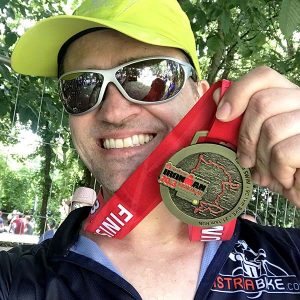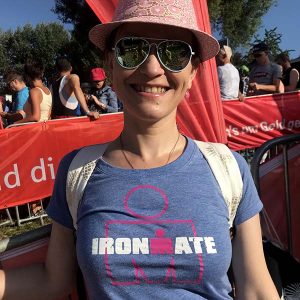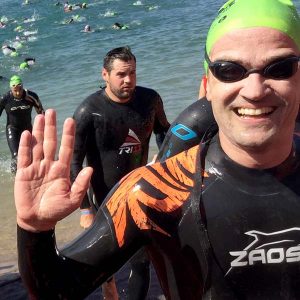Wow, what a Race!
When I registered for my first half-distance Ironman (or, more commonly, referred to as Ironman 70.3 — based on the total number of miles covered) I still couldn’t believe that I’d be able to accomplish one. Sure, I was doing quite a bit of training – but just imagining doing six hours of endurance sports during one single event sounded quite impossible to me. Well, I registered anyway, spent more than 300 Euros for signing up, and suddenly had a strong training motivation again. That was in November 2017, seven months before the race.
Yesterday, after 6 months of continuous training (but without following a strict training plan), I finished my first Ironman 70.3 in Kraichgau, Germany – with an unexpected final time of 5:39 hours! Almost everything went better than expected – great swim, very good bike leg, and a tough run at 30°C.

Pre-race: Getting prepared
Race mornings are always special – not necessarily in a positive way. Being nervous, not knowing what to eat, having mixed feelings. Along with the question: Did I train enough? Did I train smart enough? At least the weather seemed to be almost perfect. After having a light breakfast (yoghurt, muesli, coffee) I grabbed all my stuff and hit the road; accompanied by my wife and biggest supporter. After about 35 minutes in the car we arrived at the venue in Ubstadt-Weiher, parked a the car a kilometre away from the starting line and walked to the race area. A final check of my Cucuma road bike, setting up water bottles and energy bars, then off to the lake. Thousands of people, spectators and athletes, were already there. When the race organisers announced that, luckily, wearing wetsuits would be allowed (water temperature: 23,9°C), I felt relieved; it’s a lot easier to cover a long distance in a wetsuit, mostly due to buoyancy it provides.
After the pro-athletes had started their race at 9:00am, I tried to find my way through hundreds of age groupers to find the correct waiting line for my expected swimming time. The race would begin with a so-called rolling start – every 5 seconds a handful athletes are released into the water. This way the whole field of 2000+ swimmers would be stretched on purpose, giving everyone the chance to survive… downside: If you’re at the end of the pack, you easily have to wait 40 minutes or longer until it’s your turn – which can be brutal with 4mm neoprene between your skin and the bright sun.

Swim: 1,9km
Finally, I got into the lake. I had done a couple of training sessions in that very lake before, just to get familiar with the conditions. On race day, everything seemed to work perfectly. No fighting in the water, enough space around me, good sight from buoy to buoy. I kept swimming steadily, once in a while passing someone, easy-going. After the first 500 meters I still felt great, but didn’t increase the speed. I tried to keep the same pace over the full distance, which was a good choice – when I finally saw the exit point and eventually stepped out of the water, I couldn’t believe my time – 36 minutes! Definitely not world-class, but my personal best for swimming almost 2 kilometres. Stepping out of the water I even saw my wife cheering, which gave me some extra boost towards the first transition zone.

Cycle: 90km
Thanks to the heat, I was able to take off my wetsuit faster than expected; after putting on some additional sun cream and carefully changing some clothes, I headed towards my bike and then off to the road. The first 10 kilometres were quite flat, which allowed me to find a steady rhythm and get used to the cycling. It also gave me the chance to start refueling early during the race which proved to be a good strategy. After 20 minutes, the terrain started to get hilly – a total altitude of almost 1000 meters were to be covered throughout the full 90 kilometres. Prior to the race I only did four training rides longer than 80k – which seemed to be enough; during the competition (and due to my continuous calorie intake on the bike) the cycling part was steady, fast, and painless – I didn’t expect to manage the distance in less than three hours (and more than 4 litres of water)!
Run: 21,1km
By the time I finished the cycling part, temperatures had risen to about 30°C. I don’t mind high temperatures much, but having to run a half-marathon after already being racing for four hours seemed to be almost impossible to me… the first six kilometres felt accordingly terrible. My primary goal was to finish the running part in less than two hours (with a secondary goal of 1:45) but the first third of the run caused many doubts – everything hurt and some serious doubts crossed my mind whether I was able to finish that part. At this point, all those thousands of spectators along the route, especially my wife and some friends I didn’t even expect to be there, really helped to pass this phase; after about 7km it started to get better and I again was enjoying the event. After 1 hour and 55 minutes of running I crossed the finish line and completed my first Half-Ironman in 5:39 hours — faster than expected!
Aftermath
Since I’ve never done any serious triathlon before this one, I really wasn’t sure if in the end this would be a sport I could enjoy during long-distance events. But in fact, doing close to six hours of triathlon felt less exhausting then running a marathon in four hours. So, I’ll definitely go for full distance – it’s just a matter of time and training. Some things to consider looking back at the past six months and the race itself:
- Find a training plan and try to stick to it
Although it seemed to be enough for me to just without one, I probably compensated missing quality with pure quantity. That’s not gonna work anymore for a long distance triathlon. - Consider finding a coach
In order to get most out of your training plan, having someone experienced who can set it up based on my individual training needs would most probably extremely valuable. - Smarter swim training
So far, my swim training pretty much looked like this: Get in pool — swim 2k in a steady pace — get out of pool. No technical training, no speed training, no breathing training, no orientation training. During my triathlon camp earlier this year I experienced how variable a good swim exercise could be, but incorporating this into your individual work-outs is a different story… - Nutrition planning
Eating those energy bars during cycling is painful. Need to find an alternative, maybe even consider to prepare my own food – better taste, saving money. - Train accordingly to the terrain of your main competition
It was a good idea to do some training sessions in the lake and on the bike track of the actual competition. The rest of my training, though, was not at all focused on the conditions I had to expect during the race Almost all of my training I did in flat terrain. - Walk the water stations
This competition was the first one during which I consequently followed that advice – each and every water station on the route I walked, which allowed to drink a least 100-200 millilitres of water and coke. This worked out perfectly. - Go slow to finish strong
During my prior competitions (mostly marathons, half-marathons and 10k road races) I tended to start off too fast, not having enough energy left during the final kilometres. This time, I pace myself more efficiently, especially on the bike – although I usually tend to push too hard in the beginning, during this competition I didn’t. - Buy more equipment
Oh yes, that’s what triathlon is all about 😉 Buying equipment keeps one motivated (although it not necessarily makes you faster…). I’d like to upgrade from my road bike to a dedicated triathlon machine; a power meter on the bike could increase the efficiency of my cycling training.


